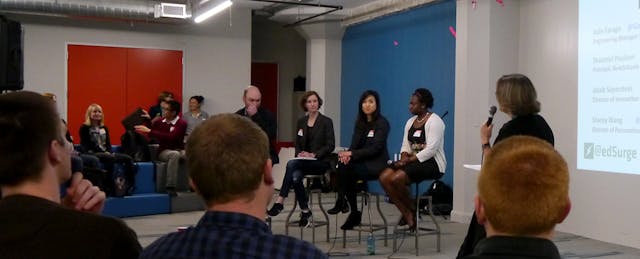Mobile is one of the biggest drivers of technology growth around the world. And with it comes the promise of learning anywhere, anytime at one’s fingertips.
But has mobile technology truly transformed the process of teaching and learning--or is it simply cramming what already exists onto a smaller screen?
Those were a few of the questions raised by EdSurge’s CEO, Betsy Corcoran at our February SF Edtech Meetup, where 130 attendees gathered to hear about the latest mobile trends from Julie Farago (Engineering Manager for Android and Play for Education at Google), Shauntel Poulson (Principal at NewSchools Venture Fund), Jacob Saperstein (Director of Innovation Policy and Social Investment, AT&T) and Stacey Wang (Director of Personalized Learning at Oakland Unified School District).
Mobile Masquerade
What mobile apps truly pass muster?
The Google Apps for Education store boasts “several thousand” apps, many of which have been vetted by teachers, says Farago. But not all apps are created equal. “There are definitely ‘dead losses’ in apps that are designed for phones but not tablets,” she explains, “and those that are web-first [but] have a real shoddy mobile interface.”
Developers often simply port existing web-based tools onto a mobile interface, shares Poulson. “Many people in education are still thinking about web-based products. Some are making them mobile responsive, but not mobile-first.”
In the pipeline of products that she reviews regularly, “we’re still seeing less than half of products which are mobile first,” says Poulson. And of the apps designed specifically for mobile, the majority deal with games and subject-specific content. The biggest area of growth, she observes, are home-to-school communication tools, while peer-to-peer collaboration apps are still scarce.
Transforming Teaching Practices, or Transferring Existing Ones?
Well-designed mobile apps can turn the dream of project-based learning into reality, says Farago. Not only can students capture and remix pictures and videos for projects, but “as a kid you can watch them, have other kids critique you [so] you can learn and get better. If that’s not 21st century learning skills, I don’t know what is.”
“What we’ve seen are big trends toward the ‘4C’s’--creativity, collaboration, communication, critical thinking--as well as a fifth C--classroom management,” Farago adds. “The apps that generally have been the most successful [in the app store] tend to be less about curriculum and more about in-classroom collaboration and 21st century skills.”
Wang says her district has recently taken up Remind, an app that facilitates communication between teachers, students and parents. “It’s not super exciting, but it solves for a real need. There’s been little parent-to-teacher communication.”
Giving parents real-time or same-day insights into their child’s learning is critical, adds Poulson. It means they no longer need to wait for teacher conferences or report cards.
“The apps disrupting education are the ones that making the black box of schools for families open up. And it’s not only about being able to send messages home about what’s happening during the school day, but having a two-way communication and dialogue,” says Poulson.
Another major change underway is rethinking how assessments and evaluations are done. “The lines between content and assessment are beginning to blur,” Poulson explains. “Even within a mobile game, you have a lot of built-in assessment happening” without the students knowing it.
Wang concurs: “It’s not just multiple choice anymore; there’s all kinds of different test questions, and how do we embed those in the game in a meaningful way?”

Proof and Privacy
But making it easier to capture and communicate data also poses risks. Everyone, from parents to the President, has urged for better safeguards to protect student data from being leaked or abused for marketing and other commercial purposes.
Privacy may be the hardest problem in edtech, according to Farago, She asks: “How do we, as technology folks, approach education in a privacy-safe and aware way and don’t go too far? We can do personalized learning without a ton of data collection, but is it the right thing for us to do?”
“The benefits far outweigh the risks,” says Poulson, “but there are a lot of misconceptions around what’s happening with the data.” Some companies have rewritten their privacy policies and even signed a pledge in an effort to be transparent. “It may not be enough...but it’s a start and at least we’re having conversation,” she observes.
There’s also much to be desired when it comes to demonstrating proof that all this data collection and analysis leads to better learning outcomes. Poulson, who frequently reviews pitches from companies, finds that “less than half have a genuine foothold in research.” Lack of existing research does not bar one from getting investment, she says, but “a lack of thinking about research will stop us from funding someone.”
In addition to studies on curriculum efficacy, Farago suggests that “the other piece of research worth investigating is, ‘What makes a good co-teacher?’ An app in the classroom is essentially is a co-teacher. And it’s not communicating with others teachers and not sharing results, it’s an ineffective co-teacher.”
Will Mobile Help Social Mobility?
Amidst the hopes and hype over mobile learning, one teacher in the audience raised an important point: Many students and families struggle to afford basic living expenses, let alone devices. “Sometimes people have a rose-tinted lens,” she observes, when it comes to assuming districts will buy iPads for every student.
“Mobile penetration is largest for people at the lower income level,” says Poulson. But not all mobile phones have the same abilities to use all the apps available today, and she urges developers to think about design tools that leverage basic technologies like SMS.
Saperstein points out that AT&T has committed $100 million to bring mobile broadband and devices to 50,000 students in low-income and rural communities. “That’s not a systemic answer to a systemic question,” he says. “We do what we can through our social impact work, but there’s always more to be done.”


